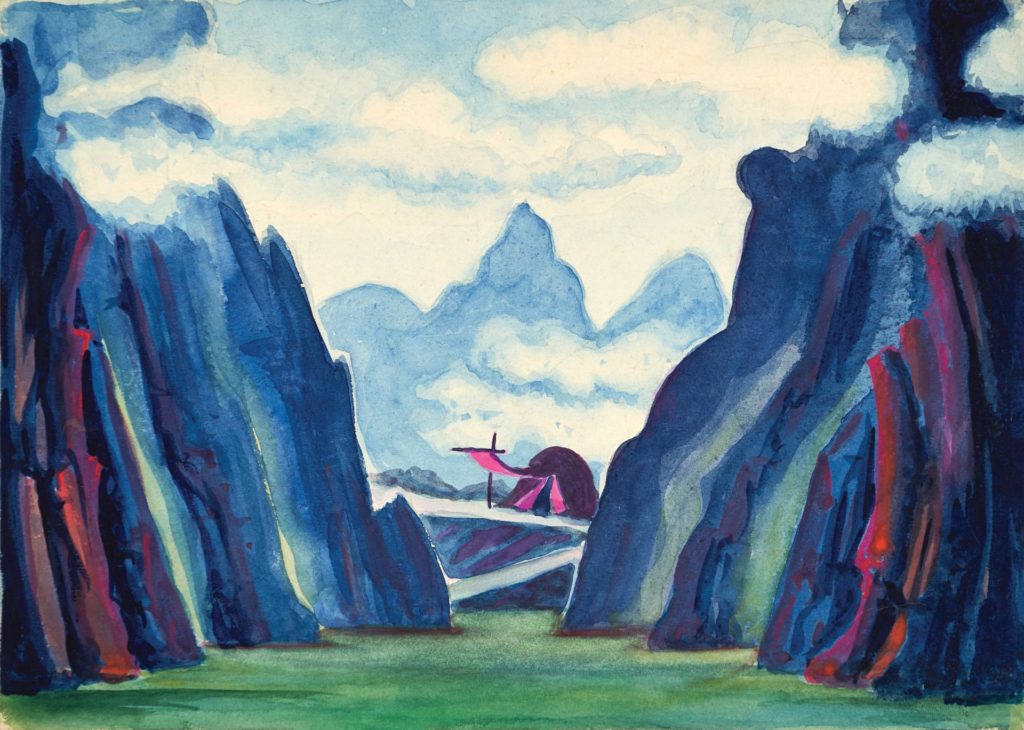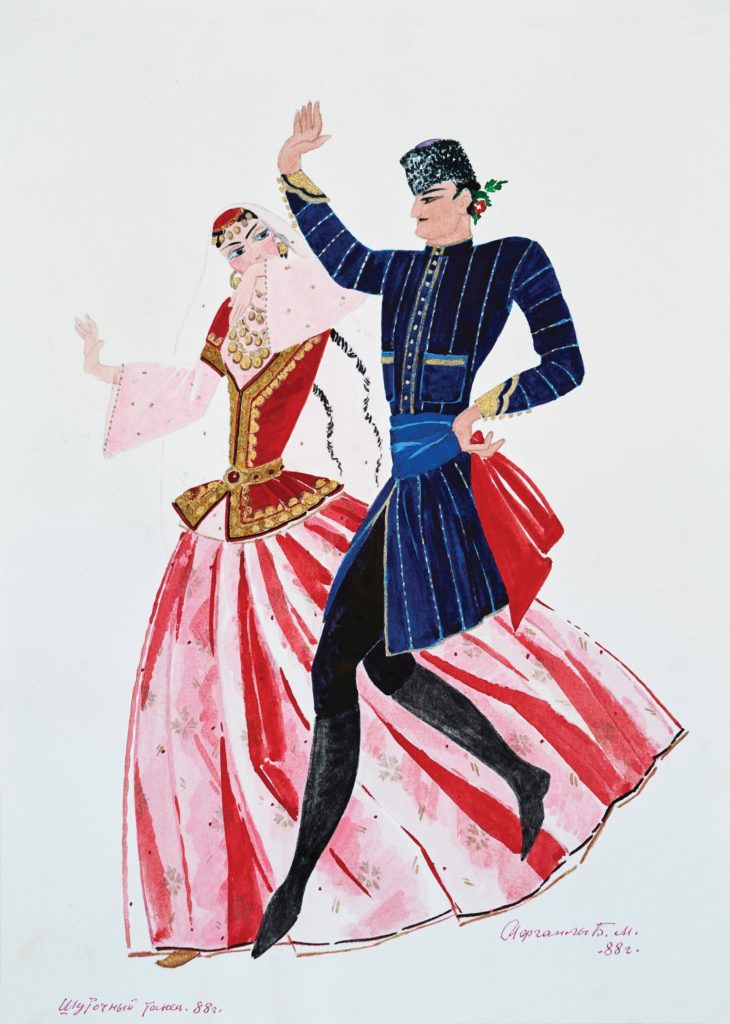“To portray the locale… does not make sense.
…it is not worth to portray Venice and Cyprus in “Othello”.
It is fruitless to represent the hall where the Senate sits
…The core is different – it is on finding the essence of the matter, the essence of the event.”
Anatoly Efros
Theatre-decorative art of Azerbaijan is inextricably linked with the history of the Azerbaijani theatre. The official date of birth of the Azerbaijani theatre is considered to be March 10, 1873, when comedy of Mirza Fatali Akhundov, “The Vizier of the Lankaran Khanate”, was held in Baku. Further on, there will still be many significant dates on the uneasy path of forming professional art of theatre, until, ultimately, a harmonious system is formed within which each of the currently functioning theatres has its own “niche”. First of all, it is primarily about theatres such as the Azerbaijan State Academic National Drama Theatre, the Azerbaijan State Academic Russian Drama Theatre, the Azerbaijan State Academic Opera and Ballet Theatre, and the Azerbaijan State Academic Musical Theatre.
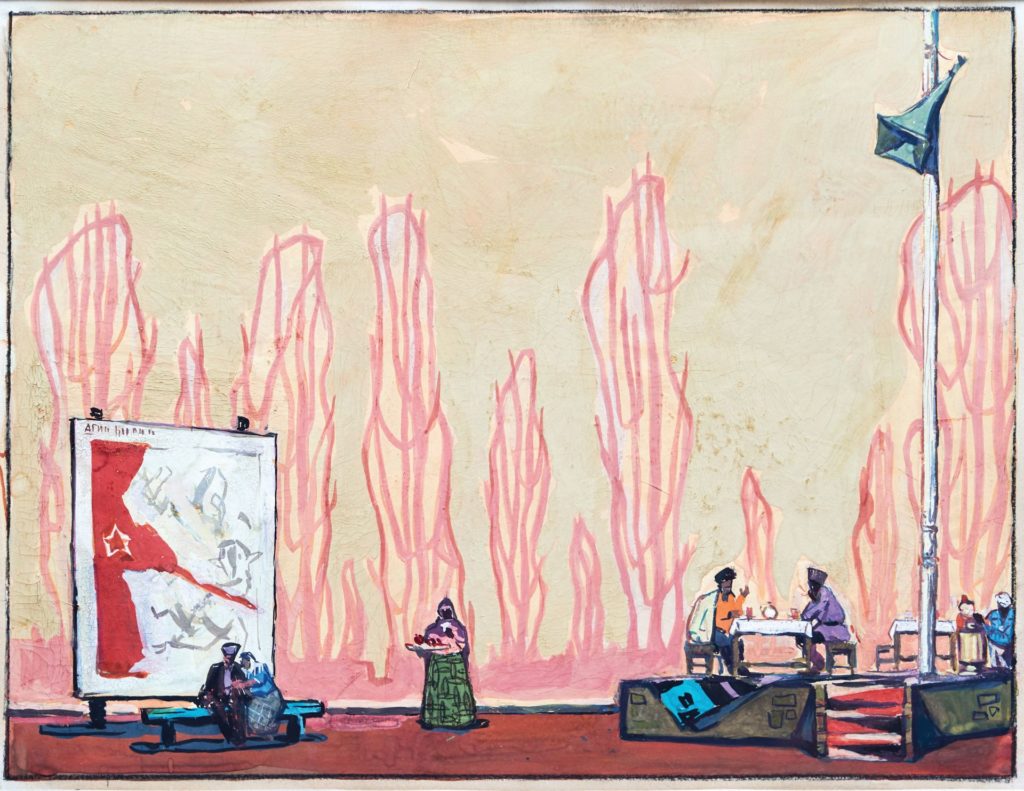
Paper, gouache, tempera. 25×33 cm
All this was preceded by the formation of various theatre societies and groups: “The First Muslim Drama Troupe”, “Union of Actors”, the drama troupe under the “Nijat” society, the Partnership of Muslim drama actors, and some others. Settings of the same pattern were delivered from abroad while the costumes and props, predominantly, consisted of donations from the local population.
The first steps in Azerbaijani scenography were taken by Bahruz Kengerli and Azim Azimzade. However, the costumes and settings they created were exclusively ethnographic in nature. Thus, the emergence of the Azerbaijani theatre as a whole organism, with a fully developed creative team and a systematic repertoire, can only be spoken of starting in 1920, when all theatre troupes with all their property were nationalized by the official decree.
The formation of the professional theatre-decorative art in Azerbaijan is associated with the name of Rustam Mustafayev, the first Azerbaijani artist who received a specialized education as a theatre artist. In 1927, the Turkic Workers and Peasants Theatre was established on the basis of the “Satir-Agit” (Satire and Agitation) Theatre in Baku, which in turn became a basis for principles of professional scenery to be gradually polished. The role of the artist in the play increased, and the setting, freeing itself from a purely illustrative, object-material function, was increasingly set the task of figurative, emotional interpretation of the events taking place on the stage.
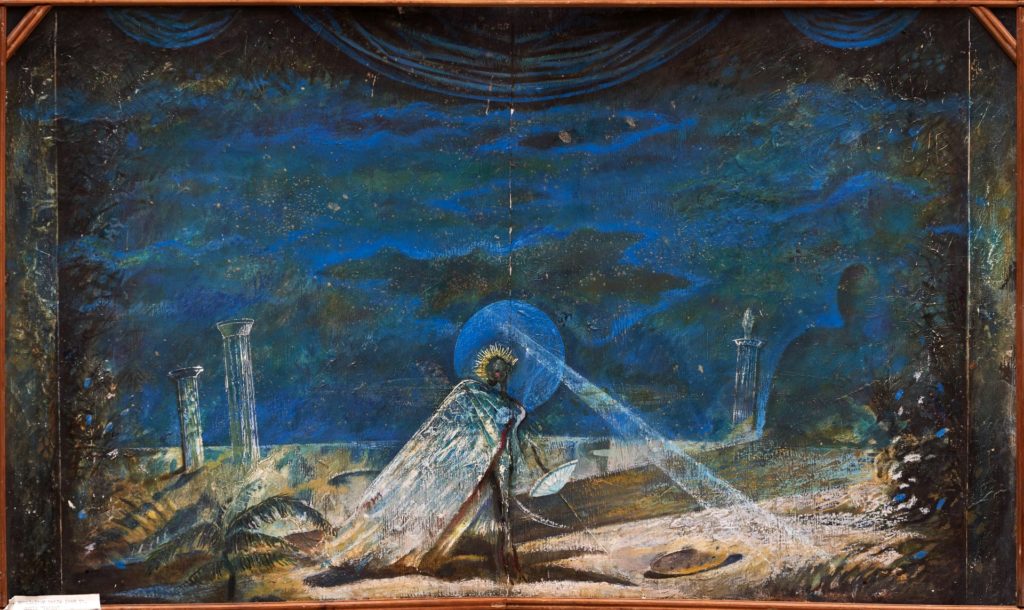
Felt-tip pen, mixed media. 60×100 cm
Already then, in the late 1920s and early 30s, there was a discussion among the leaders of the Azerbaijani theatre, that has not lost its relevance to this day: the eternal debate between realists and constructivists, between the “right” and the “left”. Rustam Mustafayev boldly introduced experimental techniques on the stage of the Baku Workers Theatre, thus the theatre productions gained a purely authorial, a conceptual character. However, the officially adopted line of the Communist Party and Soviet government in favor to socialist realism in all spheres of creativity contributed to the approval of a realistic, rather – illustrative-naturalistic, approach to productions in general, including setting and costumes, in the theatre.
The polemic between the “archaists” and “innovators” on what the theatre should be like was resumed in the 1960s, when the artists, free of the internal limits of the purely professional specifics of stage art, came to the theatre. Those artists considered the stage box a canvas available for their striking plastic solutions. They were young, progressively minded painters, graphic artists, sculptors, who, coupled with the young, talented directors, “turned” the design of theatre performances from verisimilitude towards conventionality. From now on, conventionality, in principle inherent to the art of theatre, becomes an active element of artistic expression. From now on, year after year, this cardinal renewal of the artistic language in the theatre performance becomes more and more obvious, finally taking the dominant place in the Azerbaijani theatre in the late 1970s and early 1980s.
This process of saturation of the scenography language with a symbolic meaning, when the scenic design turns into a kind of confession of the artist, into a picture demonstrating his, an exclusively individual, in-depth interpretation of the material, is clearly visible in the sketches of Nazim Beykishiev, who came to the theatre in the 1980s.
Pondering about theatre-decorative art, one should not forget that of all types of art this is the most complex, multi-component, synthetic one. The final result here always depends on the creative will of many individuals. These are a playwright, a director, an artist, and finally, the actors with their skills. Each of the participants is endowed with his/her own ambitions, each has his/her own vision of the performance as a whole, its philosophical or ideological content, the meaning and place of this or that character. Definitely: a theatre performance, like a feature film, is a result of team collaboration, the success of which directly depends on how organically the creative union of the participants of the whole process has formed.
The sketches presented in this section belong to artists of various generations, and they were created at various periods of national history for various theatres. Here are children’s performances and musical and comedy performances, the sketches for opera and ballet performances, and finally, the sketches for deep-ly dramatic, philosophical works are shown here. However, for all their thematic and genre diversity, all of them, with amazing unanimity, seem to show us the main thoughts, creative trends, emotional degree inherent to a certain time period.
Thus, the sketches created by H. Hagverdiyev for the performance of the Theatre of the Young Specta-tor “The Morning Star” are distinguished by their laconic forms, the expressiveness of which is based on the internal mobility of the composition lines, the contrasting comparison of large color planes, the gen-eralized abstract nature of the environment reconstructed on the stage. Meanwhile, this performance was dedicated, let’s say, to the “socialist way of life”, while the author of the sketches already belonged to the cohort of the oldest Azerbaijani artists, who had been brought up in a spirit of the socialist realism. Created at the same time, sketches by E. Aslanov, then a young artist, a tireless innovator of artistic forms, throughout all his life striving to develop the means of artistic expression in various kinds of art, seem to be quite consonant with these sheets in the avantgarde manner.
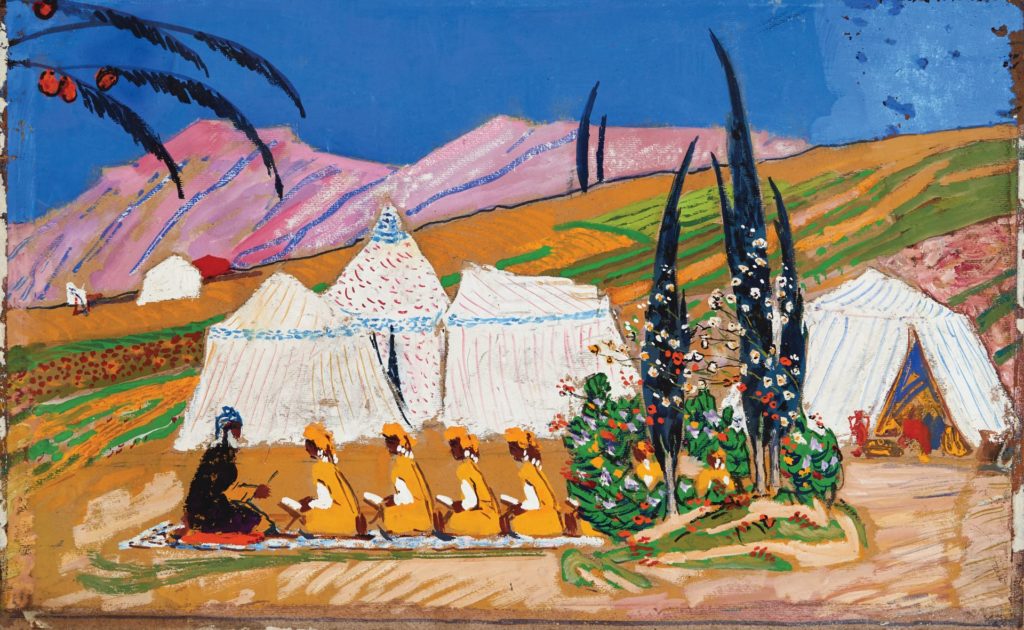
Paper, gouache. 43×71 cm
Among other authors who worked in the theatre in the 1960s and 70s there were painters who manifested themselves as independently minded, vibrant creative personalities. These were Tahir Salahov, Toghrul Narimanbeyov, Rasim Babayev, Aghasaf Jafarov, Elbay Rzaguliyev, Sanan Gurbanov. A real breakthrough in the main line of development of the national school of painting is associated with their names. The concept of the “new wave” in Azerbaijani theatre-decorative art is also associated with their names. Such recognized masters of painting as Boyukagha Mirzazade (who designed, by the way, more than 20 performances) and Mikayil Abdullayev participated in this process too.
Same was in cinematography. The 1960s and 70s were the heyday years of activity of the leading art directors at “Azerbaijanfilm” Studio – Mammadagha Huseyinov, Kamil Najafzade, Fikret Baghirov. Just as well as the masters of painting and graphics actively invaded the space of drama and musical theatre, introducing scenography into the general process of creative changes, these cinema artists, in their sketches, went far beyond the functionality of a purely staged genre, turning them into the vivid works of modern painting and graphics.
A special place in the history of theatre-decorative art of Azerbaijan belongs to the People’s Artist of Azerbaijan Badura Afganly. The first female artist in the republic to devote her entire long and fruitful life to the Azerbaijani theatre, cinematography, and dance art, for nearly 70 years, she did not just create the settings and costumes. Along with this, she was an inexhaustible researcher, a true promoter in the study and restoration of the Azerbaijani national costume. Throughout her creative life, Badura khanum tirelessly traveled over the regions of Azerbaijan, looking for craftswomen and hereditary connoisseurs of national clothes in every region, thus restoring the connection of time, the connection of generations. She had always admired with the fact that Azerbaijan, inspite of its relatively small territory, possessed the production of such a great variety of fabrics. In every region there were used its own dyes, its own dances, its own costumes.
There is no exaggeration in assertion that the national costume in Badura Afganly’s creativity, primarily supposed to be used in the Azerbaijan State Song and Dance Ensemble, as well as in many other dance groups of the republic, experienced its Renaissance, having become a unique division in its authenticity and the highest artistic quality within the Azerbaijan theatre-decorative art.
“I created what my creative intuition, my attitude and understanding of my duty to the national culture prompted me. And I consider my main achievement the uninterrupted thread of the richest ethnographic tradition that my people possesses” – these words of Badura khanum are permeated with a sense of infinite pride for the national culture and for the talented craftsmen to whom the Azerbaijani land gave birth.
The costumes created under her vigilant control, when no one detail had been leaving beyond her attention – whether the texture of fabric, or – the degree of its density or transparency, color or shade, the nature of the border or the presence of sparkles, alas, wear out or lie somewhere in dusty wardrobes. Fortunately, the artist’s sketches with her detailed comments are preserved, and many of them are kept in the collection of the Gallery.
Same to the sketches of theatre productions. The performance taking place “here and now” in its very nature is already unique. Theatre performances are not repeatable, as “one cannot enter the same river twice.” On the other hand, a theatre that is directly connected with its time, as well as with its audience, continually “changes the scenery”: some performances “leave” the stage, giving way to others. It is the sketches that are only, as a rule, preserved in single copies and isolated cases, turn out to be the very authentic documents of the era, the documents that provide us the opportunity to restore objectively the true picture of the Past. This is they, the small sheets of paper, are sometimes the only reminder of a particular performance or drama work. And that is the unique character of the collection stored in the funds of the State Art Gallery, some samples of which are presented here. This is the same imperishable asset that we must always be proud of.
